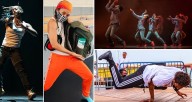This Friday, Chicago Dance Crash releases “The Last First: A Pandemic Dance Documentary,” the company’s answer to a halted 2020 season. The 50-minute film is a combination of new works by in-house and guest choreographers, a behind the scenes look at their post-quarantine rehearsal process and intimate interviews with members of the Crash Performance Ensemble. For 24 hours, fans and newcomers will be able to stream the company’s documentation of what life was like for them without the dance and each other, and their recent reunion as they returned to the studio.
What makes Chicago Dance Crash stand out to me is their ability to tell a story through dance with performances dubbed “movement plays” early in the company’s life. Chicago Dance Crash, or just “Crash” as they are affectionately known to their fans, stands out among myriad Chicago dance companies. Since 2005, Crash has collectively gone from playing noble-savages, to light-up video game warriors, to gritty urban superheroes. This time we get to see the Crash dancers be characters unique to the company's history: themselves.
That’s not to say that there isn’t plenty of individual expression by the Crash dancers in a normal season. Quite the contrary, in fact, since improvisation is such an important part of the Crash formula. We even get to know the ensemble’s individual dance styles up close and personal in Crash’s wildly popular “Keeper of the Floor” series, where members of the ensemble and special guests do solo and group battles—think “Fight Club,” but with more dancing, less cynicism and zero Meatloaf. When they’re on stage, the Crash dancers appear larger than life, but in “The Last First” we get to see what the dancers are like off stage and behind the scenes.
Down-to-earth interviews shine a light on the stress of conceiving new forms of physical art during COVID. The dancers laugh and joke around, but there are moments that show the toll that pandemic-life has had on the dancers: artistic director Jessica Deahr cruises the deserted streets of downtown Chicago in awe; dancers express their need to connect to an audience, even if it’s only a few people; dancer KC Bevis longs for human contact (she’s a hugger); dancer Porscha Spells is even sexually harassed by the male attendant at a COVID testing station during the company’s pre-concert test; while Spells is able to laugh off the experience, I personally found it revolting. Luckily for them and for us, their attitudes become buoyantly joyous once they are back at work in the studio.
Crash manages to steer clear of a stagnant fall season by presenting three new and reimagined works under Deahr’s direction. “Elastic” is an extended version of an excerpt from Crash’s “Lil Pine Nut” (2019) with choreography by Deahr and rehearsal director Bevis; “Show & Tell,” a premiere, begins with torsos heaving beneath a lone street lamp that fluidly morphs into a loving homage to “the cypher” by choreographer and Crash alum Jasper Sanchez. An extended “Sikeena” opens with dormant bodies literally popping to life and like plants growing in fast-forward find unique ways to branch out in this excerpt from a previous collaboration. The piece is excerpted from “Al Nafs” (2018) with hip hop artist Amirah Sackett, this time with an abrupt and indulgently "Chicago" house dance section added at the end by Chi-town native Keeley Morris.
Rehearsal footage shows the great lengths that the company took to keep things as safe as possible in the sunlight-drenched Extensions dance studio in Chicago’s Irving Park neighborhood. Socially distant squares are taped to the floor and some dancers have to imagine moving to a space opposed to actually doing it to remain safely distant. Some numbers are made specifically for members of Crash who are roommates—dubbed “touching buddies” in the film—who are given specific partnering work since they live together. During their technical rehearsals at the fairly intimate Beverly Arts Center, the ensemble looks humbled against the bare black-brick wall facing a vacant audience, save for a few lonely cameras.
It’s tough to see Crash’s season reduced to a modicum of its usual grandeur, but “The Last First” reminds us that the sci-fi sets and light-up costumes we’ve come to expect from them come second to quality dancing, which the company still has in spades. It is a testament to hard work and dedication that the production team and dancers of Crash are able to carry on through the pandemic and put out new work at all.
While this short film is not set in a dystopian computer game, as in “Tron” (2014), or, like “The Trials of Busta Keaton” (2011), a black-and-white motion picture, it still manages to have an otherworldly appeal. Maskless dancers sharing and creating with one another, exhibiting boundless joy and confidence and dancing like the world isn’t on fire may as well be a glimpse into a near-future utopia, or a happier parallel dimension. At any rate, getting new work from Crash means that the wheels of art and culture are still rolling and will leave you hopeful and optimistic.
--
The online screening of “The Last First: A Pandemic Dance Documentary,” takes place Nov. 13 at 7 p.m. Ticket-buyers will also have on demand access to the family-friendly film for 24 hours the following day. Tickets are $20-$40. Proceeds from the virtual ticket sales will go to the “Keep Crash Moving” COVID Relief fund. Click on the event link below for ticket and additional viewing information.



